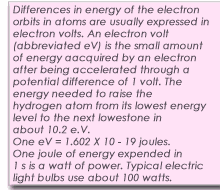
 |
"atom model".
Recall the "solar system" picture of the atom, as introduced by the great
experimental physicist Ernest Rutherford in 1911. In place of the planet would be the
orbiting electrons and instead of the sun, the central nucleus-on a tiny scale-held by
electromagnetism rather than gravity. A fundamental and seemingly insurmountable problem
is that as an orbiting electron circles the nucleus it should emit electromagnetic waves
of an intensity increasing rapidly to infinity, in a tiny fraction of second, as it
spirals inwards and plunges into the nucleus! However, nothing like this is observed.
Quantum theory came to the rescue once again in 1913, when Niels Bohr, the Danish
physicist and pioneering figure of the twentieth century proposed his quantified shell
model of the atom to explain how electrons can have stable orbits around the nucleus. To
remedy the stability problem, Bohr modified the Rutherford model by requiring that the
electrons move in orbits of fixed size and energy. The energy of an electron depends on
the size of the orbit and is lower for smaller orbits.
Radiation can occur only
when electrons jump from one orbit to another. The atom will be completely stable in the
state with the smallest orbit, since there is now orbit of lower energy into which the
electron can jump.
 |
Using Planck's constant, Bohr obtained an accurate formula for the energy levels of the
hydrogen atom. With his model, Bohr explained how electrons could jump from an orbit to
another only by emitting or absorbing energy in fixed quanta. For example, if an electron
jumps one orbit closer to the nucleus, it must emit energy equal to the difference of the
energy of the two orbits. Conversely, when the electron jumps to a larger orbit, it must
absorb a quantum of light equal in energy to the difference in orbits. Bohr's model
accounts for the stability of the atom because the electron cannot loose more energy than
it has in the smallest orbit. The quantum nature of the atom was verified in 1914 by
Gustav Herz. He made atoms absorb energy by bombarding them with electrons. The atoms
would only absorb discrete amounts of energy from the electron beam. When the energy of
the electron was below the threshold for producing an exited state, the atom would not
absorb any energy at all.